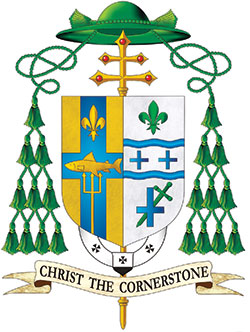Archbishop Thompson’s new coat of arms: one shield, two stories

The coat-of-arms of Archbishop Charles C. Thompson of Indianapolis. (Click on the image to see a larger version)
By Natalie Hoefer
In the ancient world, soldiers used unique crests on shields to identify military units on the field of battle.
It seems fitting, then, that the Catholic Church uses such “coats of arms” to identify dioceses of the Church Militant—the soldiers of Christ on Earth.
Symbolism abounds in coats of arms. Colors, the number of certain items, the presence or absence of particular elements—all combine to identify who presides over a particular ecclesial region.
As Archbishop Charles C. Thompson becomes the shepherd of the Church in central and southern Indiana, his coat of arms will be joined with that of the archdiocese.
In this article, The Criterion takes a look at this new coat of arms, translating the story the symbols tell about our new shepherd and the archdiocese he now leads.
To top it off
The first piece of the story comes from outside the shield, starting with the color of the hat (galero) and the tassels. The green hue identifies the ecclesial leader as an archbishop.
The galero, or hat, above the shield is reminiscent of broad-rimmed, tasseled hats worn by clergy centuries ago. Although its use was eliminated by a papal decree in 1969, the galero is still used on ecclesial coats of arms.
The number of tassels indicates the shepherd’s place within Church hierarchy. Six tassels per side indicate a bishop, 10 per side identify an archbishop, and 15 per side represent a cardinal.
Behind the shield is a gold cross, an element reserved to the coat of arms of bishops. A single horizontal bar denotes a bishop, whereas two bars indicate an archbishop. The five red jewels symbolize the five wounds of Christ on the cross.
So many symbols
The story continues with the many elements emblazoned on the shield of the coat of arms. The right side of the shield (the observer’s left) contains the archdiocesan crest. The crest on the left is the personal crest of the archbishop.
Archbishop Thompson’s crest is a tri-part plethora of meaning. The top-most symbol is the fleur de lis, which translates to “flower of the lily.” Archbishop Thompson chose this symbol for its long-standing history in the ecclesial heraldry of this area. It is taken from the arms of the Diocese of Bardstown, and it also represents the Diocese of Vincennes, which was established from the original territory of Bardstown.
In the middle of Archbishop Thompson’s crest are two wavy “barrulets” encompassing two blue crosses. The wavy bars represent several rivers of importance to the area and to the archbishop’s background: the Ohio River, which connects Indiana and his birth-state of Kentucky; the Wabash River, which was central to the Diocese of Vincennes; and the Salt River, which flows through the archbishop’s native Marion County in Kentucky. The wavy lines also represent the waters of baptism.
Between the barrulets are two blue Greek crosses. They represent the Catholic heritage that has come to him from his parents, Coleman and Joyce (Thomas) Thompson.
The final component of the Archbishop Thompson’s crest is a green sword overlaid by an inverted blue cross.
These represent the means by which
SS. Peter and Paul—two saints to whom the archbishop holds devotion—were martyred: St. Peter by being crucified upside down, and St. Paul by being beheaded with a sword. The green in heraldic terms represents loyalty in love, and blue represents strength and faith.
Serving as a background to all of these elements is the color white or silver, a hue which in heraldry signifies sincerity and truth.
A tale of two regions
On the right side of the shield is the coat of arms for the Archdiocese of Indianapolis.
It consists of a blue cross on a gold field. The cross is the ultimate symbol of faith, emphasized by the color blue and its meaning of strength and faith in heraldic terms. The cross is placed on a gold background, which signifies wisdom, generosity, glory and constancy.
Toward the top of the cross is the fleur de lis. It represents the faith brought to this area by French missionaries to the French-established fort and outpost of Vincennes.
The fish and the trident recall the Algonquin Native American people of this region. The word Algonquin means “at the place of spearing fish.” Gold, the color of the most noble metal, here symbolizes the first and most noble of the virtues: faith.
The final message
Below the shield lie the final components of the coat of arms.
First is the pallium, the white woolen cloth worn around the neck over the shoulders—as a sheep carried by Christ, the Good Shepherd—that yokes an archbishop to the pope in shepherding the flock of the universal Church. Both the physical pallium and the element on the coat of arms bear black crosses and black silk at the end of a tab attached to the front of the pallium.
According to an article on the Eternal Word Television Network’s website, “These crosses are to remind the wearer of the five wounds of Christ crucified for us,” and “the end tips of the garment are embroidered with black silk, reminiscent of the feet of the lambs the Good Shepherd laid down his life for …”
The final message of the story told by the coat of arms is written on the banner at the bottom. It is the Scripture passage Archbishop Thompson chose to adopt as his motto as a bishop, and will remain his motto no matter where he shepherds: “Christ the Cornerstone.” It can be found in Eph 2:20, as well as referenced in Psalm 118:22. †
Related: The coat-of-arms from each of our 12 previous bishops/archbishops
